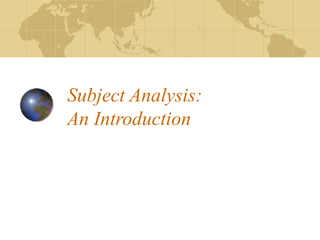
Subject analysis, an introduction
- 2. Subject analysis principles What are the basic principles of subject analysis? How do you determine what an item is about? Why do controlled vocabularies help in providing subject access?
- 3. Definitions Subject analysis is the part of indexing or cataloging that deals with the conceptual analysis of an item: what is it about? what is its form/genre/format? translates that analysis into a particular subject heading system 1st step in classification Subject heading: a term or phrase used in a subject heading list to represent a concept, event, or name
- 4. Definitions (cont.) Classification Process of organizing resources by assigning an alphanumerical string that sorts physical objects by subject
- 5. Analysis vs. indexing Analysis: Look at the work as a whole to determine its overall contents Think of terms that summarize the primary subject focus of the work Indexing: Provide in-depth access to parts of items (chapters, articles, detailed listing of topics)
- 6. Determining the subject content Examine the subject-rich portions of the item being cataloged to identify key words and concepts: Title Abstract or summary Table of contents Index Introduction or preface Illustrations, diagrams Author’s purpose or Containers forward
- 7. Types of concepts to identify Topics Names of: Persons Corporate bodies Geographic areas Time periods Titles of works Form of the item
- 8. Subjects vs. forms/genres Subject: what the item is about Form: what the item is, rather than what it is about Physical character (video, map, miniature book) Type of data it contains (statistics) Arrangement of information (diaries, indexes) Style, technique (drama, romances) Genre: works with common theme, setting, etc. Mystery fiction; Comedy films
- 9. Important factors: Objectivity Catalogers must give an accurate, unbiased indication of the contents of an item Assess the topic objectively, remain openminded Consider the author’s intent and the audience Avoid personal value judgments Give equal attention to works, including: Topics you might consider frivolous Works with which you don’t agree
- 10. Examples: Exercising objectivity The big lie : the Pentagon plane crash that never happened / Thierry Meyssan. Dawn; the herald of a new and better day. The silent subject : reflections on the unborn in American culture / edited by Brad Stetson.
- 11. Important factors: Cataloger’s judgment Individual perspective Informed by the cataloger’s background knowledge of the subject Informed by the cataloger’s cultural background Consistency in determining “What is it about?” leads to greater consistency in assignment of subject headings
- 12. Translating key words & concepts into subject headings Controlled vocabulary Thesauri (examples) • Art & Architecture Thesaurus (AAT) • Thesaurus of ERIC Descriptors Subject heading lists (examples) • Library of Congress Subject Headings • Sears List of Subject Headings • Medical Subject Headings (MeSH)
- 13. Why use controlled vocabulary? Controlled vocabularies: identify a preferred way of expressing a concept allow for multiple entry points (i.e., cross- references) leading to the preferred term identify a term’s relationship to broader, narrower, and related terms “syndetic structure”
- 14. Function of keywords Advantages: provide access to the words used in bibliographic records Disadvantages: cannot compensate for complexities of language and expression cannot compensate for context Keyword searching is enhanced by assignment of controlled vocabulary!
- 15. Examples: keyword searching challenges Above all, don’t flush! : adventures in valorous living. Let’s rejoin the human race! Dawn; the herald of a new and better day. Phantom limb
- 16. Exercises Read through the following materials and determine the subject content of each work. Create a list of key words and concepts that would be translated into a controlled vocabulary.
Notas do Editor
- What parts of a book would you look at to determine the subject?
- Can be challenging to catalog something by someone you don’t agree with politically, ethically What other kinds of controversial works might require someone to be aware of their objectivity? Mein Kampf? Works by Holocaust deniers? Extolling the virtues of communism? Book that advocates euthanasia?
- We each bring strengths and weaknesses to cataloging: depends on our perspective, which can be influenced by our knowledge; culture
- Thesaurus: (Chan) a list of controlled indexing terms used in a particular indexing system Subject heading list:
- A digression about subject searching using keywords vs. a controlled vocabulary
- Ask: what do you think these might be about? Provide with information on “phantom limb”
- Pull out English-Czech dictionary